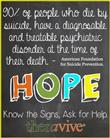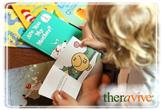October 12, 2013
by Ashley Marie

Breast cancer can touch anyone. Here is a story of love and courage in the face of this struggle.
[More]
September 12, 2013
by Christie Hunter

It can be easy to recognize depression symptoms in adults, after the turbulent adolescent years have passed. The real challenge in mental health is identifying signs of depression in teens, whose consistent moodiness may be the product of situational mood swings that are a normal part of growing up.
[More]
August 27, 2013
by Ashley Marie

Back to School Series:
I distinctly remember loving story time with my mum but dreading story time with our elementary school librarian.
With mum, I could snuggle up next to her on the living room sofa, drink a cup of hot chocolate, watch her face light up as she neared the climax of the story, and lose myself in the magic of the moment.
But with our librarian, I had to sit on a hard floor, listen to a monotonous story read aloud by a strange lady with a stiff lip, and make sure not to budge for sixty painful minutes.
So, what’s the difference between these two scenarios?
1. Find Books that Your Child Loves
Mum knew how to make it an enjoyable experience, and my librarian didn’t have a clue.
My favourite books as a child were The Chronicles of Narnia by CS Lewis. Mum had a natural gift at making the story come to life as Lucy walked through the wardrobe and into the mysterious land of Narnia, where she stumbled upon the whimsical Mr Tumnus.
Our librarian, however, thought it was a good idea to read about the rustic lives of cowboys in southern Texas – a topic that seemed like an utter bore to a nine-year-old girl clothed in a dainty pink dress and a flowery headband.
Simply put, children will do what interests them, including reading or listening to books that they actually enjoy.
As argued by Reifman, children enjoy books more when they are related to their interests.[1]
One of my younger cousins is fascinated by dinosaurs. Ever since I can remember, she has been able to cite more classifications of dinosaurs than I will ever be able to. When you walk into her bedroom, you see the shelves stacked with dinosaurs and, yes, books on dinosaurs that have been torn at the edges from overuse.
By contrast, my boyfriend spent his childhood years pouring into military history. He turned his bedroom into a military battle, which no one was allowed to touch – he wouldn’t dare reenact an anachronistic version of the events.
We all have unique interests, so let your child fall in love with his or hers. Instead of purchasing the books on your own, take them to the closest Chapters or Barnes & Noble. Maybe even treat them to a Starbucks hot chocolate – a perfect treat to accompany the first pages of their new book.
2. Make Reading a Shared Activity
Reading can also be a group activity. There is a beautiful scene in You’ve Got Mail that displays a picturesque version of how enjoyable shared reading can be. Kathleen Kelly (played by Meg Ryan) is the owner of a charming bookshop called The Shop Around the Corner. In the film, she refers to herself as the Storybook Lady, who routinely offers storytelling sessions to children in the neighbourhood. Flaunting a fairylike hat, she captivates the imagination of her young little audience.
You don’t need to wear a fairylike hat to make reading enjoyable for your child. But be creative. After all, reading is about letting your and your child’s imagination come to life.
Mascott also points out that shared reading is a great opportunity to dialogue with your child.[2] Children’s stories are often packed with morals, so it might be a good idea to help them develop their understanding of life, of right and wrong, of how one bad decision can snowball into an utter disaster, among other life lessons.
3. Encourage Them To Read Out Loud
As discussed by Johnson, some children come to hate books because they hate reading out loud.[3] If you have more than one child, it might a good idea to encourage the older sibling to practice reading out loud to the younger one.
I recall the day that my youngest sister suddenly interrupted a story that I was reading to her. To my surprise, she started reading it herself. I was speechless. But something happened in that moment. Though I did not realize it at the time, my love of reading had been passed down to my youngest sister. She realized that she too could join in on the fun.
4. Reading and Parenthood
Reading is not only a great way to help your child develop an academic skill. It also offers an opportunity for parents and children to connect, bond, and interact. The mental health of a child is intricately connected with the health of family dynamics. If you feel that your family is struggling with communication or the emotional health of your family may be at risk Family Counseling may be a great answer to equip you for the future.
Instead of trying to keep your child out of trouble by putting him or her in front of a TV screen, consider spending 20 minutes or so together – just you and your child, reading a book.
It might seem like an old-fashioned idea for the 21st century, but it is nonetheless a delightful way to spend an evening.
I will always be thankful for the stories that Mum read to me – much more than I am for PlayStation or the Cartoon Network.
[1] Reifman, S. 2011. 7 Ways to Encourage Reluctant Readers. [online] Available at: <http://www.stevereifman.com/featured-articles/for-parents/172-7-ways-to-encourage-reluctant-readers>
[2] Mascott. A. 2013. What to Do You’re your Children Hates Reading. PBS. [online] Available at: <http://www.pbs.org/parents/education/reading-language/reading-tips/what-to-do-when-your-child-hates-reading/>
[3] Johnson, L. 2013. 10 Reasons Nonreaders Don’t Read – And How to Change Their Minds. Scholastic. [online] Available at: <http://www.scholastic.com/teachers/article/10-reasons-nonreaders-dont-read-mdash-and-how-change-their-minds>
August 21, 2013
by Ashley Marie

WEDNESDAY WISDOM
Our world has been shaped by the brilliance of both male and female minds. Notable men include Sir Isaac Newton, Albert Einstein, Leonardo da Vinci, and Sigmund Freud. And notable women include Charlotte Brontë, Margaret Thatcher, Barbara Walters, and Caroline Herschel.
However, it remains a relatively taboo question to ask whether there are differences between the male and female brain. And this fear is not to be belittled. We face concerns about the mistreatment of women in the workplace, as well as abuses stemming from prejudices against another gender. These issues can produce a power imbalance between men and women, and this has historically been problematic for women.
But the above question should not be dismissed, as answering the question can help us understand the advantages of both sets of brains. This article will analyze the differences between male and female brain structures and then explore two areas in which men and women show distinct cognitive differences.
Differences in Brain Structures
The adult brain consists of approximately one hundred billion neurons and typically weighs between 2.25 and 3.5 pounds of dense matter.[1]
The brain has three principal layers.
The first of these is the brain stem, which is the bottom layer. This part of the brain is connected to the spinal cord. The brain stem is more primitive, as it is responsible for our instincts and our responses to immediate crises. Male brains tend to activate this part of the brain more often than women, which is why they are more likely to respond physically in cases where they feel threatened.
Secondly, the limbic system is the middle layer, which is where emotions are processed. The amygdala is part of the limbic system, and this tends to be larger in males, making them typically more aggressive than females.
Thirdly, the cerebral cortex is the top layer, which is where we use our cognitive skills. The left side is responsible for language skills. The right side is responsible for spatial skills, including mathematics. The following section examines both of these cognitive functions, which are especially different for men and women.
Language: Women Take the Lead
There are differences between male and female brains at a mere 26 weeks of pregnancy.[2] Scientists have found that the corpus callosum – a bundle of nerve tissues that connect the left and right parts of the brain – is actually thicker in female fetuses than male fetuses.
Dr Denckla from the Kennedy Krieger Institute, concludes that women have language functions in both the left and right hemispheres of the brain. This means that when women take part in a language-based activity, such as reading a poem, they use both sides of the brain. Men, however, only use the left side.
Similarly, Dr Geary from the University of Missouri claims that the way our brains are shaped affects the skills that we tend to enhance.
Fine motor skills associated with language learning, such as handwriting, tend to mature in girls six years prior to boys.
Jane Austen, Emily Dickinson, Margaret Atwood, Toni Morrison, and Harriet Beecher Stowe are just a few examples of women who displayed a talented fluency in the written language.
Of course, these scientific findings do not mean that men are incapable of refining their language skills to produce brilliant works. Bookshelves also boast an array of notable male writers, such as William Shakespeare, Charles Dickens, Ernest Hemingway, Mark Twain, and F. Scott Fitzgerald. The above findings simply suggest that women display an advantage in language functions, especially during early developmental stages.
Mathematics: Men Take the Lead
Studies have shown that male students display a greater facility than females when it comes to learning mathematics. A study involving 500 male and female children showed that the areas of the brain responsible for mathematic skills tend to mature in boys four years prior to girls.[3]
According to Baron-Cohen, the male brain is better equipped to develop the ability to systematize – i.e. to figure out how things work, such as a car, a military unity, or a computer. This also involves the ability to predict how a specific action will produce a certain result.
Famous male mathematicians include Pythagoras, Andrew Wiles, Wilhelm Leibniz, René Descartes, and Leonhard Euler.
Again, this does not mean that there are not also notable female mathematicians. Women of note in this domain include Hypatia, Sophie Germain, Ada Lovelace, Sofia Kovalevskaya, and Emmy Noether.
Parenthood and a Child's Cognitive Development
Because of the differences between male and female brains, especially during early stages of development, it is important for parents and teachers to recognize how to help children maximize their learning skills.
Typically, girls might require more assistance in mathematics, while boys might require more help with handwriting or the written language.
As shown through examples of brilliant minds throughout the course of the human story, both men and women are capable of pursuing their areas of interest – regardless of their brain structures. This is the beauty of the human brain: it is embedded with enormous potential, as it can be enhanced and refined throughout our lives.
What does this all mean?
As with most things in life, nothing is black and white. Sometimes the confusion that lies in issues such as parenting or even in your own understanding of work tasks can put a lot of stress on us. Working in a field where your brain just might not be best suited can challenge you in ways you may not have anticipated. Sometimes this stress can build up and we may need to see additional help. A counselor can help to dissect the issues in ones life and help to give coping tools for daily life. Sometimes we may need to seek a new career which may be better suited for our own personal gifts and talents. A career counselor can help to work on this which can lead to more satisfaction in your life and even improved relationships. Here is an article which may be able to equip you better with these possible transitions.
Male or Female we have the brain we have so let's begin to work with it and adapt as we need to.
[1] Gurian, M. 2011. Boys and Girls Learn Differently! A Guide for Teachers and Parents. San Francisco: Jossey-Bass Books.
[2] How Male and Female Brains Differ. 2013. WebMD. [online] Available at: http://www.webmd.com/balance/features/how-male-female-brains-differ
[3] Ibid.
August 19, 2013
by Ashley Marie

Bullying is a concern for parents, teachers, and children. And this challenge is becoming evermore complex as traditional bullying behaviours are taking new forms on the Internet.
School will be in session again.
Mothers are scanning flyers from department stores to snatch the latest deal on school supplies. Fathers are planning their morning and afternoon pick-up and drop-off schedules. Girls are picking out their outfit for the first day of school. Boys are gearing up for soccer tryouts.
And bullies are cracking their knuckles.
Bullying is no small challenge, and its harmful effects span across North America.
As discussed in the news this past week, Rehtaeh Parsons, a high school student in Nova Scotia, attempted suicide and passed away this year after a series of incidents of cyber bullying. The perpetrators distributed multiple photos of her online and physically raped her.
In Canada, 1 in 3 students are bullied during the academic year.[1] Sadly, of 35 countries that were studied internationally, Canada had the 9th highest rate of bullying for students at the age of 13.
In the United States, bullying has increased over the last decade.[2] Researchers estimate that 1 in 5 students are bullied over the course of an academic year, and 8% of students report to have bullied others.
Bullying Defined
Bullying involves a perpetrator who intends to harm its victim(s) emotionally and/or physically.[3] Moreover, it includes repeated incidents of emotional and/or physical aggression and is characterized by a power imbalance between two or more individuals.
According to the Canadian Council on Learning, bullying can be broken down into four broad categories: (1) physical bullying, (2) relational bullying, (3) verbal bullying, and (4) electronic bullying.[4] The last of these is a recent phenomenon that is becoming evermore dominant.
Cyber Bullying
Cyber bullying involves online forms of aggression, such as forwarding private photos or information of the victim or writing malicious comments directed at the victim on social networking sites.
Typically, there are more female than male victims of cyber bullying.
In Canada, 73% of victims of cyber bullying reported receiving aggressive emails or instant messages.[5]
In the United States, 1 in 5 teenagers has been cyber bullied and approximately the same number of teenagers have been a cyber bully.[6] Studies show that there is frequently a relationship between online and in-person bullying. Cyber bullying tends to contribute to social exclusion for female victims and tends to result in physical bullying for male victims.
It Often Starts At Home
Researchers have found that the issues that trigger bullying often stem from family dynamics at home.[7] Parents who do not provide a caring environment can harmfully affect their children, who in turn express their discontentment at school. Once the pain of life at home reaches a breaking point, children are more likely to act aggressively towards others.
It Usually Happens at School
Though the triggers that produce bullying behaviour tend to begin at home, the act of bullying typically occurs at school. Studies show that bullying occurs most prominently during recess and in the classroom.[8] Children commonly find their social life at school, so incidents of bullying are more likely to occur on school grounds.
In addition, bullies commonly seek a wider audience to which they can display their power over another. This is especially the case when teachers or supervisors are not present. For instance, schoolyards often lack sufficient supervision, making it easier for bullies to act aggressively towards their victim(s) without any punishment.
How Parents Can Help a Victim of Bullying
Though children do not always tell an adult about incidents of bullying, those who do tend to turn to their parents for help. In fact, 1 in 3 children turn to their mother or father.[9] This is a great time to asses how life for your child is in general- how is their self esteem etc. A Family Counselor can help to assist in communication with your children and working through issues you may not feel confident tackling.
But for those parents whose children have remained silent, these are some warning signs to look out for: unexplained scratches or bruises, unexplained damaged belongings, fear of walking to school or home from school, unpredictable mood swings, anxiety, poor academic performance, and having few friends.
How Parents Can Help a Perpetrator of Bullying
Once an incident of bullying has been identified, the family of the perpetrator of bullying should be notified. Because bullies commonly grow up in dysfunctional families, researchers recommend that schools involve their parents in the process of preventing future incidents of bullying. When parents must commit to actively helping their child, the positive result can be more sustainable in the long run. There are lots of stresses for Parents with back-to-school coming, to get some perspective on this read more here.
Increasing Awareness About Cyber Bullying
In the digital age that we live in, it is also important to help children navigate online social interactions. Social media sites and online forums are often the arena in which modern forms of bullying take place. Parents and teachers can educate children about proper online etiquette and inappropriate behavior. If the triggers of bullying behavior are stopped at home and in the classroom, then we can help decrease incidents of bullying overall.
[1] Canadian Bullying Statistics. 2012. Canadian Institutes of Health Research. [online] Available at: <http://www.cihr-irsc.gc.ca/e/45838.html>
[2] Bullying and Adolescent Health. 2011. Office of Adolescent Health. [online] Available at: <http://www.hhs.gov/ash/oah/news/e-updates/eupdate-7.html>
[3] Bullying in Canada. 2008. Canadian Council on Learning. [online] Available at: <http://www.ccl-cca.ca/pdfs/LessonsInLearning/Mar-20-08-Bullying-in-Canad.pdf>
[4] Ibid.
[5] Canadian Bullying Statistics. 2012. Canadian Institutes of Health Research. [online] Available at: <http://www.cihr-irsc.gc.ca/e/45838.html>
[6] Bullying and Adolescent Health. 2011. Office of Adolescent Health. [online] Available at: <http://www.hhs.gov/ash/oah/news/e-updates/eupdate-7.html>
[7] Rigby, K. 2007. Bullying in Schools and What to Do About It. Victoria, Australia: Acer Press.
[8] Ibid.
[9] Ibid.
August 4, 2013
by Ashley Marie

Back to School Series
The start of your college career is just around the corner. You’ve done your campus tour, been assigned your college dorm, signed up for your classes, said goodbye to your high school friends, listened to your parents cry as they anticipate your departure, and wondered what your life will be like as a college student.
Will you get along with your roommate? Will your professors be incredibly intimidating? Will your course load be too heavy? Will you find any extracurricular activities that you enjoy? Will you make new friends? Will you be able to manage your finances? And will these be the best or the worst four years of your life?
Although this article is by no means comprehensive, it outlines some helpful tips that I’ve gathered during my years as an undergraduate and postgraduate student. These might help you make these the best – and not the worst – years of your life.
1. Get To Know Your Roommate
If you are living with a roommate, take the time to get to know him or her. After all, you will be spending the next eight months living right next to each other. After you’ve both settled in, consider going for a walk or grabbing a coffee with him or her just to get to know each other a bit.
Even if you are complete opposites, those first conversations are crucial to understanding how to make the most of your time living together. What are your schedules like? Is he or she an early riser or a night owl? How clean or messy is he or she?
Though these might seem like trivial questions, appreciating each other’s differences in lifestyle is essential to creating a healthy living situation. Having worked as a Residence Don for two years, I witnessed a strong contrast between roommates who knew how to respect each other’s boundaries and those who didn’t.
I would even suggest writing up a quick roommate contract with a short list of what you absolutely need your roommate to respect. A few examples include the need for a quiet study space at certain times during the week, a need to have the freedom to invite friends over on Friday nights, or the need to have a decently clean living space.
2. Do Not Be Shy
If you’re like me, meeting a whole new group of strangers can be intimidating. But getting yourself out there is worth it. College is not only an opportunity to improve your mind, but it is also a tremendous opportunity to improve your social life.
Like never before, you will have endless crowds of people to interact with – from a variety of cultures, backgrounds, belief systems, interests, and ideas.
During my years as an undergraduate and postgraduate student, I noticed a marked difference between high school and college. In high school, meeting new people was more difficult – there were fewer people to befriend and people were less likely to make new friends. However, in university the atmosphere was different. I made new friends left, right, and centre – at the library, in lectures, at school clubs, at formal events, at the school pub, in dorms, and the list continues.
3. Get Involved
One thing I will never regret about my university years was my choice to get involved in extracurricular activities. Not only is it a great way to meet new people, but it is also a fantastic way to develop a new skill or try something new.
Most colleges and universities have a variety of clubs and activities to choose from, and you can often find out more about them during your orientation week. Try a few in your first month, and if it’s not the right fit, there is bound to be something else that fits you like a glove.
Try a salsa class, write for your school newspaper, join an activist group, play a sport, or perform in a play. The options are endless.
4. Start Studying Early
Unfortunately, the attractions of dorm life, a fun social life, and engaging extracurricular activities can turn into an unhealthy distraction from your studies. Map out your assignment deadlines, midterms, and final exams as soon as you get your academic syllabi. Divide up the amount of work that you will need to do to perform well, and then ensure to create a weekly schedule that realistically balances your schoolwork and your other interests.
There is no need to pull an all-nighter the day before your final exam worth 50% of your final grade. Start early, and you will be a lot less stressed and learn a lot more.
5. Spend Wisely
University tuition is already expensive, so it is important to be realistic about your finances. While it is great to go out with your friends, make sure not to overdo it. There are usually a lot of discounts available for students, so find out what deals apply to you. Can you find your books at a second-hand store? Are drinks cheaper on Tuesday nights? Is membership at your university gym cheaper than a regular gym? Saving a bit here and there makes a huge difference in the long run.
6. Do Not Forget to Call Home
During my first year as an undergraduate, I miserably failed at calling home. But this was not a healthy choice – neither for me, nor for my parents. It is important to give updates on how you are doing, to remember that there are people who care for you, and to catch up with your loved ones. If your parents are helping you out financially, then remember to thank them every once in a while. If grandma sent you a box of baked cookies, then give her a call to let her know that you appreciate her. There are people who helped you get to where you are today, and they want to know that you remember them.
7. Do Not Be Afraid to Seek Help
Being away from home can be difficult. Researchers have found that the stress of a first failed midterm or a low grade on an assignment can lead to a vicious cycle of hopelessness, lack of motivation, and declining academic performance.[1] Universities often experience a peek in the number of students coming to seek help during final exam season. At McGill University, for instance, their mental health clinic serves four times the number of students close to the end of the academic year.[2]
If you are feeling stressed, lonely, discouraged, or anxious, do not be afraid to seek help. Your college has a variety of staff available to help you, including a team of mental health professionals. If you just need to talk to someone, there is always a listening ear available. Find out where your college’s counseling office is, and be encouraged that you are not the only one on campus who is finding your new life as a university student a bit of a challenge. Yes, you can make these the best years of your life.
[1] Hanlon, C. 2012. Addressing mental health issues on university campuses. State of Mind. [online] Available at: < http://www.aucc.ca/wp-content/uploads/2012/06/mental-health-state-of-mind-university-manager-article-summer-2012.pdf>
[2] Bradwhaw, J. and Wingrove, J. December 07, 2012. As student stress hits crisis levels, universities look to ease pressure. Globe and Mail. [online] Available at: < http://www.theglobeandmail.com/news/national/as-student-stress-hits-crisis-levels-universities-look-to-ease-pressure/article5902668/>
December 11, 2012
by Gloria Day

Well on the eve of Christmas I think it is timely that we deal with this chapter called “Boundaries and Your Family”
A few important things have stuck out for me in this section. Primarily, how we can make a change on the outside yet if the change is not in our hearts or in our minds or our values then it will only be actions and in fact, we will be easily swayed to the old way; as well as, possibly feel guilty for this internal inconsistency.
Specifically, this relates to how we have separated ourselves from our families. We may have chosen to move to a different town, gotten married, even had kids, yet we still feel a pull from the familial roots we have come from as we have not made a change to move away in our hearts. This moving away is a sign of maturity and growth.
Later in the chapter we read about how God asks us to really leave our families and to be adopted by Him.
Have you done that?
Do you identify with who you are as the daughter of “Sally” or as a ‘Daughter of the King’ ?
Where is your compass set to?
Towards your family of origin and the guilt, hurts, and abuse from the past OR towards Freedom and the future?
I was just discussing today how this Christmas will probably be full of stress and unmet expectations. A Godly friend questioned me with whom do I identify? With the sins of my family’s past and the guilt and codependency of my youth or with the freedom I can have in Christ ?AND where are my expectations…if on ANYONE but God I am sure to get disappointed this holiday season!
It seems like the rubber meets the road for me in this Chapter. I desire to be well rounded. To have my mind and heart focused on God’s goodness, yet I seem to get pulled back into needing affirmation and approval by people who actually cannot even fully affirm or approve me!
“Many times we are not obeying the Word of God because we have not spiritually left home.”(Pg 138)
Here are a few points on how to bring resolution to boundary problems in the family
<!--[if !supportLists]-->1)<!--[endif]-->Identify the Symptom
<!--[if !supportLists]-->2)<!--[endif]-->Identify the conflict
<!--[if !supportLists]-->3)<!--[endif]-->Identify the need that drives the conflict
<!--[if !supportLists]-->4)<!--[endif]-->Take in and receive the good
<!--[if !supportLists]-->5)<!--[endif]-->Practice boundary skills
<!--[if !supportLists]-->6)<!--[endif]-->Say no to the Bad
<!--[if !supportLists]-->7)<!--[endif]-->Forgive the Aggressor
<!--[if !supportLists]-->8)<!--[endif]-->Respond, Don’t React
<!--[if !supportLists]-->9)<!--[endif]-->Learn to love in freedom and responsibility , Not in guilt
Well, I desire as Christmas comes closer to apply these items and to hopefully have a love, peace, and boundary filled holiday!
Reference: Cloud, H., & Townsend, J. (1992) Boundaries: When to say Yes, When to say No; to take control of your life. Grand Rapids, Michigan: Zondervan.
December 7, 2011
by Christie Hunter

By Tanya Glover
Theravive.com Contributor
“Those who cannot remember the past are condemned to repeat it.” ~George Santayana
As a huge history buff, I want so much for my children to have a love for it as well. To me, history tells a story much better than fiction and teaches us to better understand the world around us. The questions “who are we” and “where did we come from” are answered through history. These are important questions in defining the world as we know it and understanding the worldviews of others. There are many places I want to be able to take my children for this purpose. These places are good for family fun and make history something that is enjoyable to young minds. Hopefully, they will inspire a love of history for my children and yours as well.
Charleston, South Carolina
Charleston, South Carolina is brimming with history. This is a perfect vacation spot to learn about a very important part of our nation’s history, catch some sun on the beautiful beaches and get a great seafood meal. Charleston is where the Civil War began. The first shot was fired from Fort Sumter, which is visible from Battery Park. You and your family can get on the ferry boat and cruise over to the fort for a tour. This can be an exciting for children, especially if they have never been on a ferry ride. The fort is in excellent condition and has been preserved very well. The tour will make this era come alive for both children and adults, making all involved want to know more of the history surrounding Charleston and the Civil War. In addition to the tour of Fort Sumter, there are several homes and plantations in Charleston that can make history touch your child’s mind. The best one that I experienced as a child was Boone Hall Plantation. Here you will tour the main house on the plantation. It contains most of the original furniture and has the slave quarters intact for exploring as well. (The history of slavery in the United States has always been of interest to me since being introduced to it in Charleston.) The tours are given by people in period dress, making it fun for children and allowing them to really experience that time in history. To inspire your child’s love for history, Charleston is a must.
Salem, Massachusetts
Many children love witches, ghosts and goblins. This is why Salem is the perfect place to take a vacation if you want to get them into history. Massachusetts was one of the original 13 colonies so it has much history to share. Here your child can learn about the Puritan people, their way of life and what it was like to live in Massachusetts during the 1600’s. They may be especially interested in the Salem Witch Trials that took place in 1692. There are several places in Salem to learn about this time in history but the most visited is the Salem Witch Museum. There you will find out about the bleak time in history where regular people were accused of being supernatural beings and being put to death for their “crimes”. The most compelling feature of this museum is the stage show that is given. It is a dramatic showing and really pulls you back into history. As a child I remember reading the book about the Witch Trials and being so taken with the history that I had to know more. Most children enjoy stories about witches so Salem is the perfect place to show them their real part in history.
Washington, D.C.
Our nation’s capital is a great place to get your children involved in history. There are so many things to do that can spark their interest in the past and keep them wanting to learn more. One must see in D.C. is the Smithsonian Museum. It would be more accurate to say museums as there are 19 separate sites for the Smithsonian. The museum of American history is a fantastic collection of history that will excite your children’s minds. Here they can see our first president’s uniform, Thomas Jefferson’s lap desk and the ruby slippers worn by Dorothy herself in the movie the Wizard of Oz. They will also see historic items left behind by first ladies’, original machines that were built for communication, items from everyday domestic homes and pieces of original military history. You can then head over to the air and space museum and learn about air travel, starting with its birth. The very first plane constructed by the Wright Brothers in on display and is a big hit with children. Space travel is also well illustrated and the night sky can come to life in the show seen in the planetarium. From American history to the American Indian Museum and the history of space travel to the history of motor car travel, you can spend a week going through all the collections contained within the halls of the Smithsonian buildings. Looking back, I can honestly say that this location was the top inspiration I had for falling in love with history. But, the museums are not place to go for historic inspiration. The White House and the Lincoln Memorial are also fantastic places to visit. These tell the story of our nation’s birth and history in a way that one will never forget.
Philadelphia, Pennsylvania
Even though Washington, D.C. is our nation’s capital, Philadelphia, Pennsylvania is the birthplace of America herself. This is the place where the founding fathers of our country lived and the place where the Declaration of Independence was signed. If you want your children to really understand how the country was born, this is the place to go. One of the coolest attractions for your child in this town is The Liberty Bell. The history of the bell will be explained right down to the visible crack in its side and why it is an important symbol for America. Your next stop should be Independence Hall. Here you will get the tour of a lifetime. Guides dressed in period clothing will take you through the hall where the Declaration of Independence was signed and re-enact that important day in history. Finally, you should not miss Franklin Court. This is the spot in which Benjamin Franklin’s home stood. Though it was burned to the ground long ago, there is a steal framed outline where the house once sat and a post office in which you can send someone special a post card that has the hand stamped post mark made with the original stamp belonging to Franklin himself. How many children can say that they held Benjamin Franklin’s post mark stamp in their very own hands?
The places I have spoken of are a few of the many historic places that your children will love. You do not even have to leave your own state to find history that will inspire your children. History is everywhere. If travel is not possible, begin in your own town’s historic society. Learning about the history of your own town can get that spark going. Once this happens the flame will grow and your children will hunger for more information from the past.
November 7, 2011
by Christie Hunter

ByTanya Glover
Theravive.com Contributor
Once upon a time, Bipolar Disorder was only a mental illness recognized in adults. Over the past few years however, this disorder has become something that has been recognized in children. Many feel that this is just the new buzz diagnosis from the medical community, but I have personally seen cases of bipolar disorder in children. Maybe more kids are diagnosed with this serious disorder then should be, but regardless of that, it is a real disorder that does touch the lives of children.
What is Bipolar Disorder?
Once known as manic depression, bipolar disorder is a mental illness that causes your mood and energy to shift in dramatic ways. There are severe ups and downs in the mood of a person suffering from bipolar disorder. This is difficult for adults to deal with even though they have an understanding of what is going on, but for children, it can be very scary. Most children are not capable of understanding such an illness and it can make them abnormal and distanced from others their age. Typically, this illness develops during the late teenage years or during the early adult years, but it is now becoming clearer that signs and symptoms are beginning to show during early childhood.
What are the Symptoms?
People with bipolar disorder have intense mood swings. They can be overjoyed and completely blissful or they can be dangerously angry or deeply depressed. It has been found that children with bipolar disorder tend to experience odd sleep patterns, changes in energy levels and change is amounts of activity compared to how they usually behave and engage. Other signs and symptoms include:
ØThe child experiencing an overly hyper or silly mood that is not typical
ØShort temperedness
ØRacing thoughts
ØInability to concentrate
ØPartaking in risky behavior that goes beyond typical childhood mischief.
ØStaying in a sad mood
ØHaving little interest in things that used to be enjoyable
ØNoticeable changes in eating
ØThoughts of death or talking about death
ØSevere behavior problems beyond what is normal for the child
You may look at this list and worry that your child may suffer from bipolar disorder but rest assured, most children have at least a few of these symptoms. They may be going through a stage that will soon pass. The important thing when looking at a list of signs and symptoms is to remember that your child is not bipolar simply because he his one or two symptoms. Many other things are taken into consideration before a diagnosis this serious is given.
How is Diagnosis Made in Children?
While there are no medical tests that can give a proper diagnosis for bipolar disorder, things such as blood tests and brain scans may be used. This is not to determine if your child is bipolar but to rule out any other medical possibility. When it comes right down to it, the only real way to be diagnosed is through careful questioning and observation. Questions about your child’s habits such as sleep patterns, eating habits, and mood changes will be covered as well as family history. If someone else in your family has bipolar disorder than your child is at more of a risk of getting it as well. The final diagnosis is made from the guidelines found in the DSM or Diagnostic and Statistical Manual of Mental Disorders. The DSM has defined four specific types of bipolar disorder:
ØBipolar 1 Disorder
ØBipolar 2 Disorder
ØBipolar Disorder Not Otherwise Specified
ØCyclothymic Disorder
Your child’s health care professional will do a case study and determine which type of bipolar disorder your child has, if any.
Differences for Children vs. Adults
While the symptoms tend to be the same, studies have shown that when a child is found to have bipolar disorder, the symptoms come on in a much more severe way. Adults with bipolar disorder can get the illness under control more easily. This is not so for children. It appears that children who are bipolar tend to have more frequent mood shifts that are more severe in nature. They also are sick more often than other children. Suicidal thoughts are also very common in bipolar children. These signs must be taken very seriously. Having an illness like this can be very confusing for a child and therefore harder to cope with.
Treating the Bipolar Child
While there is not a cure for bipolar disorder, there are ways to treat it in both adults and children. The main treatments are therapy and medication. Many times it is beneficial to use both of these to get the most out of the treatment. While medication can be a good thing for the bipolar child, doctors are still in the early stages of treating children with this disorder and only have adult studies to go on. Studies have been started on this topic though since the diagnosis is becoming more common. This is an important point to remember because the way children respond and react to psychiatric drugs can be very different than how adults respond and react. Some doctors are beginning to use adult medications in an experimental capacity on children with bipolar disorder. Currently, there are only three drugs approved by the FDA to treat bipolar children:
ØLithium
ØRisperidone (Risperdal)
ØAripiprazone (Abilify)
Also commonly used are mood stabilizers and antidepressants. Be sure to know all the side effects of these types of medications before your children begin taking them. Watch closely and report any adverse reactions to the prescribing physician.
Therapy for Bipolar Children
In addition to medication, therapy can be very useful in helping your child to work within his or her capacity to deal with their disorder. An especially useful tool is cognitive behavioral therapy. With this type of treatment your child can learn how to change any harmful patterns of thoughts and behaviors. In some cases, family therapy may be needed as having a bipolar child can take its emotional toll on the family unit as a whole.
Having a child with bipolar disorder can be a major challenge for you and for them. They are scared and you are their protectors. It can be hard to stay strong for them and you do not have to do it alone. If you find yourself needing more support take to the web and find a parental support group where you can find other parents who have children with bipolar disorder. This can be very cathartic and if you are feeling stronger then you can pass some of that strength onto your child.
September 30, 2011
by Christie Hunter

The family of today is typically a very busy unit. Most households require both parents to work in o
[More]